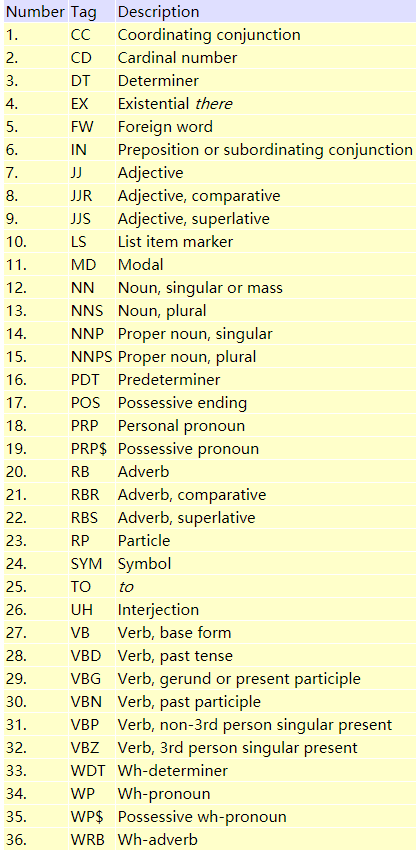POS Tagging 标签类型查询表(Penn Treebank Project)
在分析英文文本时,我们可能会关心文本当中每个词语的词性和在句中起到的作用。识别文本中各个单词词性的过程,可以称为词性标注。
英语主要的八种词性分别为:
1、名词(noun)
2、代词(pronoun)
3、动词(verb)
4、形容词(adjective)
5、副词(adverb)
6、介词(preposition)
7、连词(conjunction)
8、感叹词(interjection)
其他还包括数词(numeral)和冠词(article)等。
在使用第三方工具(如NLTK)进行词性标注时,返回的结果信息量可能比上述八种词性要丰富一些。比如NLTK,其所标注的词性可以参考Penn Treebank Project给出的pos tagset,如下图:

举例来说,我们使用NLTK对一段英文进行词性标注:
这段英文摘自19年3月13日华盛顿邮报有关加拿大停飞波音737客机相关报道,段落的原文为:
After the Lion Air crash, questions were raised, so Boeing sent further instructions that it said pilots should know,” he said, according to the Associated Press. “Those relate to the specific behavior of this specific type of aircraft. As a result, training was given by Boeing, and our pilots have taken it and put it into our manuals.
我们对该段落进行断句,然后对每句话进行分词,再对每个词语进行词性标注,然后循环打印每句话中每个词的词性标注结果,具体代码如下:
import nltk
passage = """After the Lion Air crash, questions were raised, so Boeing sent further instructions that it said pilots should know,” he said, according to the Associated Press. “Those relate to the specific behavior of this specific type of aircraft. As a result, training was given by Boeing, and our pilots have taken it and put it into our manuals."""
sentences = nltk.sent_tokenize( passage )
for sent in sentences:
tokens = nltk.word_tokenize( sent )
posTags = nltk.pos_tag( tokens )
print( posTags )
代码的print()函数打印的内容如下:
[('After', 'IN'), ('the', 'DT'), ('Lion', 'NNP'), ('Air', 'NNP'), ('crash', 'NN'), (',', ','), ('questions', 'NNS'), ('were', 'VBD'), ('raised', 'VBN'), (',', ','), ('so', 'IN'), ('Boeing', 'NNP'), ('sent', 'VBD'), ('further', 'JJ'), ('instructions', 'NNS'), ('that', 'IN'), ('it', 'PRP'), ('said', 'VBD'), ('pilots', 'NNS'), ('should', 'MD'), ('know', 'VB'), (',', ','), ('”', 'FW'), ('he', 'PRP'), ('said', 'VBD'), (',', ','), ('according', 'VBG'), ('to', 'TO'), ('the', 'DT'), ('Associated', 'NNP'), ('Press', 'NNP'), ('.', '.')]
[('“Those', 'JJ'), ('relate', 'NN'), ('to', 'TO'), ('the', 'DT'), ('specific', 'JJ'), ('behavior', 'NN'), ('of', 'IN'), ('this', 'DT'), ('specific', 'JJ'), ('type', 'NN'), ('of', 'IN'), ('aircraft', 'NN'), ('.', '.')]
[('As', 'IN'), ('a', 'DT'), ('result', 'NN'), (',', ','), ('training', 'NN'), ('was', 'VBD'), ('given', 'VBN'), ('by', 'IN'), ('Boeing', 'NNP'), (',', ','), ('and', 'CC'), ('our', 'PRP$'), ('pilots', 'NNS'), ('have', 'VBP'), ('taken', 'VBN'), ('it', 'PRP'), ('and', 'CC'), ('put', 'VB'), ('it', 'PRP'), ('into', 'IN'), ('our', 'PRP$'), ('manuals', 'NNS'), ('.', '.')]
如何看懂上面的输出结果:段落中的每句话为一个list,每句话中的每个词及其词性表示为一个tuple,左边为单词本身,右边为词性缩写,这些缩写的具体含义可以查找Penn Treebank Pos Tags表格。
我们对代码稍微修改一下,以便使结果呈现更清楚一些,而不至于看的太费力,如下:
import nltk
passage = """After the Lion Air crash, questions were raised, so Boeing sent further instructions that it said pilots should know,” he said, according to the Associated Press. “Those relate to the specific behavior of this specific type of aircraft. As a result, training was given by Boeing, and our pilots have taken it and put it into our manuals."""
sentences = nltk.sent_tokenize( passage )
for sent in sentences:
tokens = nltk.word_tokenize( sent )
posTags = nltk.pos_tag( tokens )
for tag in posTags:
print( "{}({}) ".format( tag[0], tag[1] ), end = "" )
输出结果如下(标注的词性以括号形式紧跟在每个单词右侧):
After(IN) the(DT) Lion(NNP) Air(NNP) crash(NN) ,(,) questions(NNS) were(VBD) raised(VBN) ,(,) so(IN) Boeing(NNP) sent(VBD) further(JJ) instructions(NNS) that(IN) it(PRP) said(VBD) pilots(NNS) should(MD) know(VB) ,(,) ”(FW) he(PRP) said(VBD) ,(,) according(VBG) to(TO) the(DT) Associated(NNP) Press(NNP) .(.) “Those(JJ) relate(NN) to(TO) the(DT) specific(JJ) behavior(NN) of(IN) this(DT) specific(JJ) type(NN) of(IN) aircraft(NN) .(.) As(IN) a(DT) result(NN) ,(,) training(NN) was(VBD) given(VBN) by(IN) Boeing(NNP) ,(,) and(CC) our(PRP$) pilots(NNS) have(VBP) taken(VBN) it(PRP) and(CC) put(VB) it(PRP) into(IN) our(PRP$) manuals(NNS) .(.)
参考文献:
1、https://en.wikipedia.org/wiki/Part_of_speech
2、https://www.ling.upenn.edu/courses/Fall_2003/ling001/penn_treebank_pos.html
3、https://www.washingtonpost.com/local/trafficandcommuting/canada-grounds-boeing-737-max-8-leaving-us-as-last-major-user-of-plane/2019/03/13/25ac2414-459d-11e9-90f0-0ccfeec87a61_story.html?utm_term=.f359a714d4d8
POS Tagging 标签类型查询表(Penn Treebank Project)的更多相关文章
- html <input>标签类型属性type(file、text、radio、hidden等)详细介绍
html <input>标签类型属性type(file.text.radio.hidden等)详细介绍 转载请注明:文章转载自:[169IT-最新最全的IT资讯] html <inp ...
- 第五篇、HTML标签类型
<!--1.块级标签 独占一行,可以设置高度和宽度 如:div p h ul li -----display: none(隐藏标签) block(让行内标签变块级标签) inline(让块级标 ...
- POS tagging的解釋
轉錄文章~~ 什么是词性标注(POS tagging) Tue, 04/13/2010 - 10:36 — Fuller 词性标注也叫词类标注,POS tagging是part-of-speech t ...
- 什么是词性标注(POS tagging)
词性标注也叫词类标注,POS tagging是part-of-speech tagging的缩写. 维基百科对POS Tagging的定义: In corpus linguistics, part-o ...
- CSS标签类型和样式表继承与优先级
标签类型 块级标签 什么是块级标签:在html中<div>. <p>.h1~h6.<form>.<ul> 和 <li>就是块级元素 块级标签 ...
- Penn Treebank
NLP中常用的PTB语料库,全名Penn Treebank.Penn Treebank是一个项目的名称,项目目的是对语料进行标注,标注内容包括词性标注以及句法分析. 语料来源为:1989年华尔街日报语 ...
- 创建标签的两种方法insertAdjacentHTML 和 createElement 创建标签 setAttribute 赋予标签类型 appendChild 插入标签
1. 建立字符串和insertAdjacentHTML('beforeEnd', ) 2. 通过createElement 创建标签 setAttribute 赋予标签类型 appendChild ...
- NFC 标签类型
NFC 标签类型 Type 1:Type 1 Tag is based on ISO/IEC 14443A. This tag type is read and re-write capable. T ...
- 伪类的格式重点:父标签层级 & 当前标签类型
伪类的格式重点:父标签层级 & 当前标签类型 通过例子说明: css1: span:nth-of-type(2){color: red;} css2: span :nth-of-type(2) ...
随机推荐
- synchronized(this) 与synchronized(class) 之间的区别
一.概念 synchronized 是 Java 中的关键字,是利用锁的机制来实现同步的. 锁机制有如下两种特性: 互斥性:即在同一时间只允许一个线程持有某个对象锁,通过这种特性来实现多线程中的协调机 ...
- Java基础小知识1——分别使用字节流和字符流复制文件
在日常使用计算机过程中经常会涉及文件的复制,今天我们就从Java代码的角度,看看在Java程序中文件复制的过程是如何实现的. 1.使用字节流缓冲区复制文件 示例代码如下: import java.io ...
- php curl_errno 60
问题描述 使用curl进行微信统一下单,curl 错误 curl_errno 60 错误码60 因为使用了证书配置项,所以要配置curl证书 解决方法 下载证书并配置php.ini ,配置curl证书 ...
- (一)Servlet简介
相关名词解释 HTML:Hyper Text Markup Language,超文本标记语言 HTTP:Hyper Text Transfer Protocol,超文本传输协议 URL:Uniform ...
- public_handers.go
package],,) ],,) ]:],,);:],],,) ) ]],,) )) ,) )) if etagMatch { w.WriteHeader(ht ...
- 如何使用Docker部署一个Go Web应用程序
熟悉Docker如何提升你在构建.测试并部署Go Web应用程序的方式,并且理解如何使用Semaphore来持续部署. 简介 大多数情况下Go应用程序被编译成单个二进制文件,web应用程序则会包括模版 ...
- sort.go
package clientv3 type SortTarget int type SortOrder int const ( SortNone SortOrder = iota So ...
- LuoguP4234_最小差值生成树_LCT
LuoguP4234_最小差值生成树_LCT 题意: 给出一个无向图,求最大的边权减最小的边权最小的一棵生成树. 分析: 可以把边权从大到小排序,然后类似魔法森林那样插入. 如果两点不连通,直接连上, ...
- linux内核参数注释与优化
目录 1.linux内核参数注释 2.两种修改内核参数方法 3.内核优化参数生产配置 参数解释由网络上收集整理,常用优化参数对比了网上多个实际应用进行表格化整理,使查看更直观. 学习linux也有不少 ...
- Python并发编程之深入理解yield from语法(八)
大家好,并发编程 进入第八篇. 直到上一篇,我们终于迎来了Python并发编程中,最高级.最重要.当然也是最难的知识点--协程. 当你看到这一篇的时候,请确保你对生成器的知识,有一定的了解.当然不了解 ...
